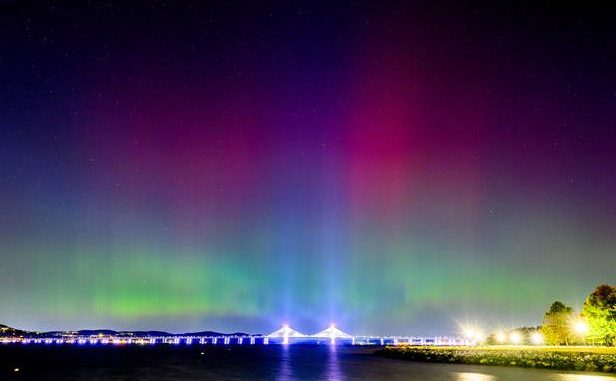
“we’re in for a ride”: Northern lights forecast for tonight show best areas in U.S. to see aurora borealis
The northern lights made an incredible display over much of the United States on Thursday — and might make a return appearance Friday night.
The aurora borealis was visible as far south as Florida on Thursday. Photos show the sky lit up in red and purple, even in some brightly-lit areas like New York City and Chicago.
The strong geomagnetic storm that created such a show has subsided, according the National Oceanic and Atmospheric Administration, but some parts of the U.S. may again see the northern lights tonight. Here’s what to know.
Where will the northern lights be visible tonight?
The NOAA Space Weather Prediction Center’s aurora forecast indicates that the northern lights will be visible in some areas of the northern United States. The northern lights can be seen from as far away as 620 miles away if the conditions are favorable, according to NOAA, although the aurora will be visible over most of Canada and Alaska.

It’s possible to see the lights Friday night in certain areas of South Dakota, Wisconsin, Idaho, and Minnesota. On the East Coast, northern New York and portions of Vermont and New Hampshire may see auroras. Maine may also witness northern lights in certain areas.
When it gets dark outside, the lights will be seen in the north. If your eyes aren’t able to see them, you might be able to see them with a phone camera or another gadget.
What time will the northern lights be most visible?
The northern lights are most visible just after sunset or just before sunrise, NOAA said. The aurora is not visible during the day. Dark, cloudless skies with little artificial light provide the best viewing experience.
Why have the northern lights been so visible lately?
The sun has been extremely active over the past few months, causing a number of coronal mass ejections to occur from its surface, according to CBS Boston. Multiple aurora shows have been witnessed as a result of that.
According to CBS Boston, the geomagnetic storm that produced Thursday’s breathtaking skies is now waning. This implies that while there will be fewer chances to witness the aurora on Friday, there might be more in the future.
The location of the sun in its 11-year solar cycle is the reason for the recent intensity of the northern lights, according to Shawn Dahl, a prediction coordinator with the Space Weather Prediction Center, who spoke with CBS Boston. “We are in the midst of solar maximum,” according to Dahl.
“What that means is the sun is now this twisted-up mass of strong magnetic fields, and some of these are so localized and intense they reveal themselves as these sunspot groups,” Dahl explained. “That’s the source of a bunch of the space weather storms that we’re looking for and predict.”

What causes the northern lights?
The northern lights are caused by interactions between the sun’s solar winds and the Earth’s protective magnetic field, according to NOAA. Those two phenomenons result in geomagnetic storms and increased geomagnetic activity.
Your chances of viewing the aurora are better the more geomagnetic activity there is. The aurora will become brighter, more active, and visible farther from the planet’s poles due to increased geomagnetic activity, according to NOAA.
According to NOAA, even mild solar wind can produce an aurora, therefore there is typically a feeble aurora visible from someplace on Earth. Near the planet’s poles, such as in Greenland or southern Argentina, are the finest locations to witness these softer auroras. The aurora is known as the “northern lights” if it is seen close to the North Pole. “Southern lights” refers to the same phenomena that occurs close to the South Pole.
Leave a Reply